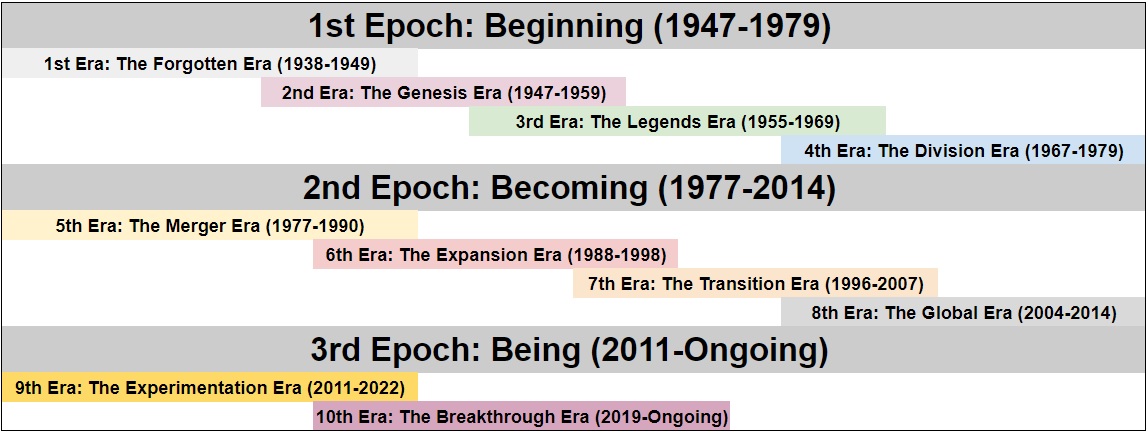
NBA fans, analysts, coaches, and players love to compare players from different chronological periods. The quest for the greatest of all time (GOAT) seems to be unstoppable and every generation has its own idea about who should be considered as the GOAT. The common format of these type of discussions is usually involving a comparison of players from different decades.
A decade is what most people, participating in this type of conversations, use to refer to as an era of basketball. This way basketball in the 90s is compared with basketball in the 80s. Identifying the top players of a decade and the main characteristics of basketball during that decade is a standard procedure in most intra-decade comparisons. However, a decade is but a chronological period and nothing more.
To clarify, in this post I argue that basketball events and players define basketball eras and not chronological periods. This means that when the 70s ended, basketball did not necessarily passed to a new era. It is the protagonists and the evolution of the game, the rule-changes and the style-changes, that determine the eras. Using decades to signify eras is easy and makes discussion about different chronological periods of the NBA possible for everybody, since it provides a common ground for the discussion; most people know when a decade starts and when it ends. Defining NBA eras though is in itself interesting and once it is done, a much more accurate depiction of NBA’s history becomes possible.
Historians, periodize history based on continuity and change; continuity defines an epoch or an era and change determines the beginning of either a new era or of a whole epoch. An epoch for this post refers to the chronological period that consists of numerous eras and has a common thread, something that defines it and remains present in all eras that make up the epoch. The moment that this common feature ceases to exist a new epoch begins. Different eras within an epoch are underlined by the common characteristic of their epoch, but they gradually move away from it. Consequently, the final era within an epoch would be furthest from the defining characteristic of its epoch; every new era is a step towards a new epoch.
In addition, eras and epochs necessarily overlap with each other. This means that the beginning of a new era or a new epoch does not mean the instant end of the previous one. It is not like a decade that stops when another one starts. This is because the new or the change need sometime until they become the new norm. Therefore, the overlap, a period during which the old and the new co-exist, is part of the change or of the move from one era or epoch to another.
This continuity and overlapping does not mean that NBA history is one unified period. Instead, NBA history and the division of NBA history in epochs and eras are the products of various forces that operate at the same time but not necessarily toward a specific common goal. The subjective goals of players, coaches, managers, owners, and commissioners collide within a environment that is the result of other internal forces, regulations and game rules, and external ones, such as the social circumstances and the technological advancements. The outcome is NBA history as we observe and experience it.
Identifying single origins of change and continuity within this complex field is impossible. This is because there are no single origins; there is not a single event that signals the beginning of a new era or epoch. Change is always a result of a plethora of events happening at the same time and for their own purpose. However, change is usually represented in a dominant occurrence that can be identified for the purposes of this post as the defining one. In NBA’s case this could be the end of a dynasty, the retirement of a dominant player or a change in the fundamental rules of the game.
Following this logic and looking into various events and occurrences, I came up with the following epochs (larger periods of time, comprising various eras) and eras (smaller periods of time that make up an epoch):

It is a random event that the first two epochs consist of four eras. The third epoch, the one that we currently experience, may end up having three or five eras. It is interesting though that through at least my criteria a pattern unveils itself. It may indeed be proven, through observing this occuring repeatedly, that each NBA epoch compriseds four eras or that it is about 30 to 40 years long.
This is the basis of the analysis I intend to present in this page and maybe this is the boring part, but out of this I think many very interesting posts will be published that will include the all-era teams, all-epoch teams, the main changes and events that brought forth change and ultimately a list of the top players that ever played in the league we love so much. I hope you will enjoy reading them and please feel free to post your comments.
